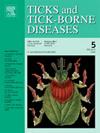韩国双性和孤雌亚洲长角蜱(长角血蜱)的比较分布和种群遗传学
IF 3.4
2区 医学
Q2 INFECTIOUS DISEASES
引用次数: 0
摘要
亚洲长角蜱(长角血蜱)是一种外寄生虫,可向人类和动物传播几种病原体,包括伴血小板减少综合征的严重发热病毒。长角瓢虫的野生种群是通过双性和无性繁殖策略维持的。本研究对韩国春川(CC)、束草(SC)、三陟(SCH)、江华(GH)、尚州(SJ)、蔚山(US)、晋州(JNJ)、保宁(BR)、高昌(GC)、珍岛(JD)、济州(JJ)和西归浦(SG)等12个城市的两性和孤雌长角瓢虫种群的地理分布和遗传分化进行了研究。根据16S核糖体DNA序列分析,发现孤雌和双性恋个体在不同地区以不同比例共存。单性生殖个体在东北地区(CC、US、SJ、SC、GH和SCH)占主导地位,而双性生殖个体在西南地区(SG、BR、JD、JJ、GC和JNJ)占主导地位。基于线粒体细胞色素c氧化酶亚基I (COI)和细胞色素B (CytB)基因串联的群体遗传分析表明,雌性蜱的遗传结构主要受其生殖策略(双性恋或孤雌生殖)的影响,而不是地理来源的影响。人口统计学分析发现,在东北(CC、SC和SCH)和西南(JD和SG)地区都有人口扩张的证据。这些发现有助于加深对韩国长角蜱种群动态的认识。本文章由计算机程序翻译,如有差异,请以英文原文为准。

Comparative distribution and population genetics of bisexual and parthenogenetic Asian longhorned tick (Haemaphysalis longicornis) in the Republic of Korea
The Asian longhorned tick (Haemaphysalis longicornis) is an ectoparasite that transmits several pathogens, including severe fever with thrombocytopenia syndrome virus, to humans and animals. Wild populations of H. longicornis are maintained by both bisexual and asexual reproductive strategies. This study examined the geographical distribution and genetic differentiation of bisexual and parthenogenetic H. longicornis populations collected from 12 cities across the Republic of Korea: Chuncheon (CC), Sokcho (SC), Samcheok (SCH), Ganghwa (GH), Sangju (SJ), Ulsan (US), Jinju (JNJ), Boryeong (BR), Gochang (GC), Jindo (JD), Jeju (JJ), and Seogwipo (SG). Based on 16S ribosomal DNA sequence analysis, parthenogenetic and bisexual individuals were found to coexist at varying proportions depending on the region. Parthenogenetic individuals were more dominant in the northeastern regions (CC, US, SJ, SC, GH, and SCH), while bisexual individuals were more abundant in the southwestern regions (SG, BR, JD, JJ, GC, and JNJ). Population genetic analysis based on concatenated mitochondrial cytochrome c oxidase subunit I (COI) and cytochrome B (CytB) genes revealed that the genetic structure of female ticks was primarily influenced by their reproductive strategy (bisexual or parthenogenetic), rather than by geographic origin. Demographic analysis detected evidence of population expansion in both northeastern (CC, SC, and SCH) and southwestern (JD and SG) regions. These findings enhance the understanding of H. longicornis population dynamics in the Republic of Korea.
求助全文
通过发布文献求助,成功后即可免费获取论文全文。
去求助
来源期刊

Ticks and Tick-borne Diseases
INFECTIOUS DISEASES-MICROBIOLOGY
CiteScore
6.90
自引率
12.50%
发文量
185
审稿时长
6-12 weeks
期刊介绍:
Ticks and Tick-borne Diseases is an international, peer-reviewed scientific journal. It publishes original research papers, short communications, state-of-the-art mini-reviews, letters to the editor, clinical-case studies, announcements of pertinent international meetings, and editorials.
The journal covers a broad spectrum and brings together various disciplines, for example, zoology, microbiology, molecular biology, genetics, mathematical modelling, veterinary and human medicine. Multidisciplinary approaches and the use of conventional and novel methods/methodologies (in the field and in the laboratory) are crucial for deeper understanding of the natural processes and human behaviour/activities that result in human or animal diseases and in economic effects of ticks and tick-borne pathogens. Such understanding is essential for management of tick populations and tick-borne diseases in an effective and environmentally acceptable manner.
 求助内容:
求助内容: 应助结果提醒方式:
应助结果提醒方式:


